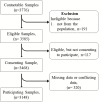Neuroepidemiology study of headache in the region of Jammu of north Indian population: A cross-sectional study
- PMID: 36686511
- PMCID: PMC9850838
- DOI: 10.3389/fneur.2022.1030940
Neuroepidemiology study of headache in the region of Jammu of north Indian population: A cross-sectional study
Abstract
Background: Headache disorders now represent a major public health problem globally. It is more prevalent in developing countries with the rising trends of headache disorders observed in young adults affecting their quality of life negatively. Very little information is available on the epidemiology of headache disorders in the Jammu Division of the north Indian population.
Aim: The aim of the present study was to find out the prevalence of headache and its two major types, i.e., migraine and tension-type headache (TTH), in the population of the Jammu Division.
Methods: The present study was conducted in two phases: (Phase I: face-to-face interview and Phase II: E-based sampling) and the sufferers of headaches were incorporated into the study based on the International Classification of Headache Disorder-3 (ICHD-3) criteria for a representative sample. Frequency distribution and mean ± standard deviation were used in descriptive statistics to describe the data sets, while a t-test, chi-square test, multiple logistic regression, and prevalence ratio were used in inferential statistics.
Results: In the present study, a total of 3,148 patients were recruited, with an overall prevalence of headache of 53.84%, with a majority of females (38.18%) over males (15.66%). As regards the type of headache, migraine was found to be of the more prevalent (33.25%) type than the TTH (20.58%). Females suffering from migraine showed the highest prevalence (25.28%), in contrast to females suffering from the TTH (12.89%). Sociodemographic variables, such as gender [female; AOR = 2.46, 95% CI (2.12-2.85), p-value < 0.0001] and marital status [married; AOR: 1.46, 95% CI (1.11-1.92) p-value = 0.006], showed a significant association with the headache.
Conclusion: The present study shows that the prevalence of headache is high in the Jammu Division of Jammu and Kashmir (J&K) India, with migraine being the highly prevalent type.
Keywords: Jammu; headache; migraine; north India; prevalence; tension type headache.
Copyright © 2023 Sudershan, Pushap, Younis, Sudershan, Bhagat, Kumar, Panjalyia and Kumar.
Conflict of interest statement
The authors declare that the research was conducted in the absence of any commercial or financial relationships that could be construed as a potential conflict of interest.
Figures






Similar articles
-
Headache prevalence and demographic associations in the Delhi and National Capital Region of India: estimates from a cross-sectional nationwide population-based study.J Headache Pain. 2024 Jun 28;25(1):108. doi: 10.1186/s10194-024-01814-2. J Headache Pain. 2024. PMID: 38943062 Free PMC article.
-
Temporal trends of migraine and tension-type headache burden across the BRICS: implications from the Global Burden of Disease study 2019.Front Neurol. 2023 Dec 22;14:1307413. doi: 10.3389/fneur.2023.1307413. eCollection 2023. Front Neurol. 2023. PMID: 38187142 Free PMC article.
-
The prevalence of headache disorders among medical students in Vietnam: a cross-sectional study.J Headache Pain. 2024 Nov 18;25(1):199. doi: 10.1186/s10194-024-01912-1. J Headache Pain. 2024. PMID: 39558238 Free PMC article.
-
Prevalence of Migraine and Other Types of Primary Headache in China: A Systematic Review and Meta-Analysis.Neuroepidemiology. 2025 Feb 25:1-11. doi: 10.1159/000543086. Online ahead of print. Neuroepidemiology. 2025. PMID: 39999811
-
Pericranial Total Tenderness Score in Patients with Tension-type Headache and Migraine. A Systematic Review and Meta-analysis.Pain Physician. 2021 Dec;24(8):E1177-E1189. Pain Physician. 2021. PMID: 34793636
Cited by
-
A Comprehensive Investigation into the Association Between Mthfr C677t, A1298c, and Ace I/D Variants and Risk of Migraine: an Updated Meta-Analysis of Genetic Association Studies with Trial Sequential Analysis and Meta-Regression.J Mol Neurosci. 2023 Dec;73(11-12):884-911. doi: 10.1007/s12031-023-02164-5. Epub 2023 Oct 16. J Mol Neurosci. 2023. PMID: 37843720
-
Assessing the Causal Effect of Pulse Pressure on Migraine Risk: A Mendelian Randomization Study.J Pain Res. 2025 Jun 25;18:3159-3170. doi: 10.2147/JPR.S512795. eCollection 2025. J Pain Res. 2025. PMID: 40584772 Free PMC article.
-
A Comprehensive Investigation of Risk Association Between the -786 T > C, + 884 G > A, VNTR, rs743506, rs3918226 of eNOS and Susceptibility of Migraine: A Updated Meta-Analysis Utilizing Trial Sequential Analysis.J Mol Neurosci. 2023 Dec;73(11-12):956-975. doi: 10.1007/s12031-023-02167-2. Epub 2023 Oct 30. J Mol Neurosci. 2023. PMID: 37902933
-
Role of TNF-α in the Pathogenesis of Migraine.Pain Res Manag. 2024 Jan 3;2024:1377143. doi: 10.1155/2024/1377143. eCollection 2024. Pain Res Manag. 2024. PMID: 38213956 Free PMC article. Review.
-
Enlightening the association between TNF-α -308 G > A and migraine: a meta-analysis with meta-regression and trial sequential analysis.BMC Neurol. 2023 Apr 21;23(1):159. doi: 10.1186/s12883-023-03174-x. BMC Neurol. 2023. PMID: 37085790 Free PMC article.
References
-
- Steiner TJ, Stovner LJ, Jensen R, Uluduz D, Katsarava Z, Lifting Lifting The Burden: the Global Campaign against Headache . Migraine remains second among the world's causes of disability, and first among young women: findings from GBD2019. J Headache Pain. (2020) 21:137. 10.1186/s10194-020-01208-0 - DOI - PMC - PubMed
LinkOut - more resources
Full Text Sources
Research Materials

